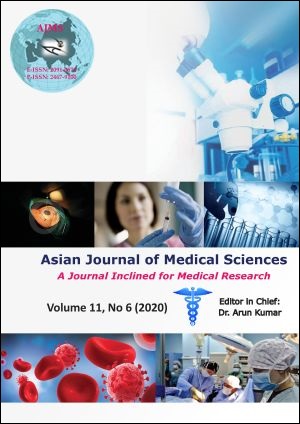A Comparative study of intraoperative peritonsillar infiltration versus intravenous dexemedetomidine for perioperative analgesia in tonsillectomy
Keywords:
Tonsillar surgery, Dexmedetomidine, Analgesia, Sedation Hemodynamics, SpO2Abstract
Background: Tonsillectomy is one of the most common surgical procedures in population and post tonsillectomy pain affects analgesic consumption, hospital stay, oral intake and return to regular activity.
Aims and Objectives: The purpose of the study was to compare peritonsillar infiltration and intravenous administration of dexmedetomidine for perioperative analgesia in tonsillectomy.
Materials and Methods: This was a placebo-controlled study to compare peritonsillar infiltration and intravenous administration of dexmedetomidine in patients undergoing tonsillectomy. Ninety patients were included in this study on the basis of a predefined inclusion and exclusion criteria. These patients were divided in 3 groups on the basis of whether they received Peritonsillar dexmedetomidine, intravenous dexmedetomidine or intravenous normal saline. The groups were compared for post-operative pain, time to first request of rescue analgesia (duration of analgesia), post-operative sedation, analgesic requirement during first 24 hours and side effects. SSPS 21.0 was used for statistical analysis and p value less than 0.05 was taken as statistically significant.
Results: Out of total 90 patients included in this study there was a female preponderance with a M: F ratio of 1:1.5. The mean age and ASA grades and mean duration of surgery of patients in all 3 groups were found to be comparable with no statistically significant difference in any of the groups (P>0.05). Preoperative mean systolic and diastolic blood pressures as well as mean arterial pressure and SPO2 was found to be comparable in all 3 groups. However intraoperative blood pressures (systolic, diastolic as well as mean arterial pressures) and SPO2 showed significant difference amongst the groups (P<0.05). Time to first request of rescue analgesia was found to be more in group - Dpt than group – Div and group – Pb which was highly statistically significant (p <0.0001).There was statistical significant difference in number of diclofenac injections consumed during first 24 hours between group – Dpt & group – Div and highly significant difference between group – Dpt & group – Pb, group – Div & group – Pb.
Conclusion: Peritonsillar infiltration of dexmedetomidine is better alternative to intravenous dexmedetomidine in tonsillar surgeries.
Downloads
Downloads
Published
How to Cite
Issue
Section
License
Authors who publish with this journal agree to the following terms:
- The journal holds copyright and publishes the work under a Creative Commons CC-BY-NC license that permits use, distribution and reprduction in any medium, provided the original work is properly cited and is not used for commercial purposes. The journal should be recognised as the original publisher of this work.
- Authors are able to enter into separate, additional contractual arrangements for the non-exclusive distribution of the journal's published version of the work (e.g., post it to an institutional repository or publish it in a book), with an acknowledgement of its initial publication in this journal.
- Authors are permitted and encouraged to post their work online (e.g., in institutional repositories or on their website) prior to and during the submission process, as it can lead to productive exchanges, as well as earlier and greater citation of published work (See The Effect of Open Access).




